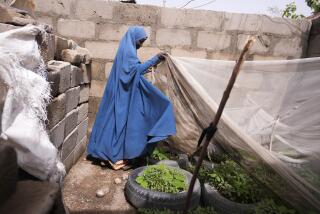Starving Amid Plenty
- Share via
Cuba’s Fidel Castro, not known as a humanitarian, made an obvious but important observation at last year’s World Food Summit. If the world produces more than enough food to feed all of its people, he asked, why should even one person starve?
Yet children the world over, Cuba included, face a food crisis, according to a UNICEF report released earlier this month. Nearly 7 million youngsters die yearly from malnutrition, deaths that could be prevented, according to the State of the World’s Children report. Others suffer stunted growth, slowed mental development and various lifelong ailments because of prolonged and extreme hunger. And premature deaths are not limited to children. As many as 12 million adults die annually from starvation, a Times series on famine reported. Famine is prevalent in parts of Africa, Asia, India and South America. Politics, corruption and wars are the primary causes.
The rains may come in Sudan, for example, but the army’s “scorched earth” policy in the long civil war will ruin any chance for a decent crop. Floods attributed to the El Nino weather system have destroyed much of Somalia’s crops, and relief efforts are threatened by fighting between Somali factions seeking control of the country.
The last time Somali children were starving to death, the United States and other nations rushed in with food and other relief supplies. Warring factions reacted to the expensive, lifesaving operations by attacking and killing U.S. soldiers who had risked their lives far from home. That 1992 debacle contributed to a compassion fatigue that still deters many potential donors from responding to foreign needs.
The scope of the hunger problem seems daunting. Nearly half of the children in South Asia and a third of the children in sub-Saharan Africa are malnourished, according to Carol Bellamy, UNICEF executive director. But she also points out solutions that need not break the bank. A couple of pennies worth of iodized table salt and four cents worth of vitamin A can reduce mortality rates, prevent brain damage, lessen mental retardation and eliminate other consequences of malnutrition among children. Contributions can be funneled through UNICEF, Save the Children, the Red Cross and other international charities, especially those programs that contribute to self-sufficiency.
Culture is a factor. In some parts of the world, male-dominated societies starve women and girls, making them eat after the men and boys have eaten what they want. The lack of food is hardest on pregnant women and damages their unborn children. The U.N. World Food Program tailors solutions to gender inequities. In Pakistan, for example, a U.N. program gives families cooking oil when they send their daughters to school. This effort boosts female literacy along with nutrition.
Research may provide the ultimate cure for hunger. In La Jolla at the Scripps Research Institute, an international team of scientists works to alter the genetic makeup of cassava, the starchy root crop known in this country as tapioca, which can sustain 500 million people a year if scientists can make it more resistant to viruses, bacteria and other problems that decimate the yields of subsistence farmers. The Rockefeller Foundation is funding research into how to grow better rice, the world’s most important staple.
Reducing malnutrition will require private and public efforts, internal and external. On this issue, even Castro is right. Why should one person starve?
(BEGIN TEXT OF INFOBOX / INFOGRAPHIC)
Hungry Children
Percentage of children under 5 who are underweight.
Sub-Saharan Africa: 30
Middle East & North Africa: 17
South Asia: 51
Latin America & Caribbean: 10
East Asia & Pacific: 20
Source: UNICEF
More to Read
Sign up for Essential California
The most important California stories and recommendations in your inbox every morning.
You may occasionally receive promotional content from the Los Angeles Times.










